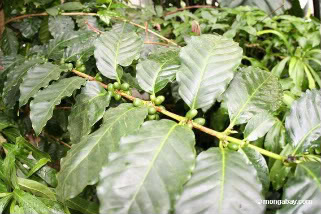Shade-grown coffee protects more than birds and bats
|
|
A new study finds that shade-grown coffee protects the biodiversity of tree species, as well as those of birds and bats. Published in Current Biology, the study found that native trees in shade-grown coffee plantations aid the overall species’ gene flow and can become a focal point for reforestation.
“Shade coffee farms allow birds and bats to move and disperse seeds throughout the coffee landscape, promoting plant gene flow,” said Shalene Jha, a graduate student whose interests in insects led her to studying shade-grown coffee farms. “This is unlike most agricultural systems, which do not provide habitat for seed dispersers, and thus limit the distance plant seeds can move. By supporting important seed dispersal processes, shade coffee farms maintain plant population gene flow across fragmented habitats.”
When a habitat is fragmented, as is the case of many tropical habitats near agricultural regions, gene flow from one population of plant species to another becomes increasingly difficult. If gene flow is constricted it can lead to inbreeding and even extinction.
 Coffee bush. |
Jha took DNA analysis from the tree species, Miconia affinis, in three different shade coffee farms in Chiapas, Mexico. The analysis proved that the coffee farms retained extensive gene flow in native understory tree species. Each of the subject farms had a similar history: the forests were slash-and-burned in the 1930s when the farms planted coffee bushes. Through the decades, the farmers then followed the traditional practice of allowing native understory trees like Miconia to return, since the trees acted as a buffer against erosion. The practice also provides habitat for native bats and birds, which do their part for coffee farmers by feeding on insects.
“More than 60 percent of the earth’s surface is managed by humans as agriculture or pasture, and these landscapes provide us with a great opportunity to support native biodiversity,” Jha said. “Many studies have shown that conserving native biodiversity in agricultural systems can actually benefit crops—by preventing pest outbreaks and providing native pollinator services. Our study shows that agricultural crops can also benefit native trees living across the landscape.”
Shade coffee farms have a production life of around a century, after the production life ends the farm can become a key place for reforestation projects, since the area already has a jump start toward second-growth forests with a number of native trees and wildlife.
Despite the ecological importance of shade-grown coffee, many farmers are feeling pressure to change traditional farms into coffee monocultures because of increasing demand for coffee. “A lot of the rustic coffee farms are turning into sun-intensive operations, where farmers cut down the overstory and try to level out the fields so it’s easier to get machines in,” Jha said.
A prior study showed that traditional farms in Mexico retain about 94-97 percent more bird species than industrialized monoculture farms. In addition, monoculture farms require large amounts of pesticides and fertilizers in order to remain viable. While monoculture farms produce more coffee than traditional ones, Jha believes that shade-grown coffee is imperative to ensuring habitat and long-term sustainability.
“It’s more essential than ever to pay attention to the ecological benefits shade coffee farms provide,” she explains.
Shalene Jha and Christopher Dick. Shade coffee trees promote genetic diversity of native trees. Current Biology, Volume 18, Issue 24, December 23rd, 2008.
Related articles
Eco-friendly shade-grown coffee buffers farmers against climate change October 3, 2008
Shade-grown coffee plantations will be more resistant to climate change than conventional plantations, report researchers writing in the journal Bioscience. Shade grown coffee is already lauded for its environmental benefits including supporting high levels of biodiversity and requiring less fertilizers and pesticides.
Coffee plantations may preserve some bird species in Costa Rica June 18, 2007
Agricultural areas offer opportunities for conservation in deforested landscapes in the tropics, reports a study published in the April 2007 issue of the journal Conservation Biology by Stanford University biologists.